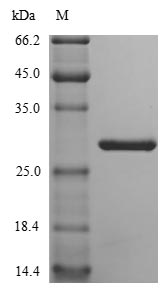Unlock the potential of your research with the Recombinant Mouse Nid1 protein. This protein closely mirrors the native Nidogen-1 (also known as NID-1 and Entactin) present in Mouse species, making it an ideal candidate for varied research applications.
This recombinant protein covers a partial expression region from 428-665 amino acids, precisely cloned and expressed in a yeast system for optimal functionality. For the convenience of detection and minimal interference with the protein’s activity, the protein is tag-free, allowing for studies in conditions mirroring the natural biological environment.
The Recombinant Mouse Nid1 protein assures high reliability in your experiments, with purity greater than 90% as confirmed by SDS-PAGE. It is available in both liquid and lyophilized powder forms, providing you the flexibility to choose the right format for your experiments.






